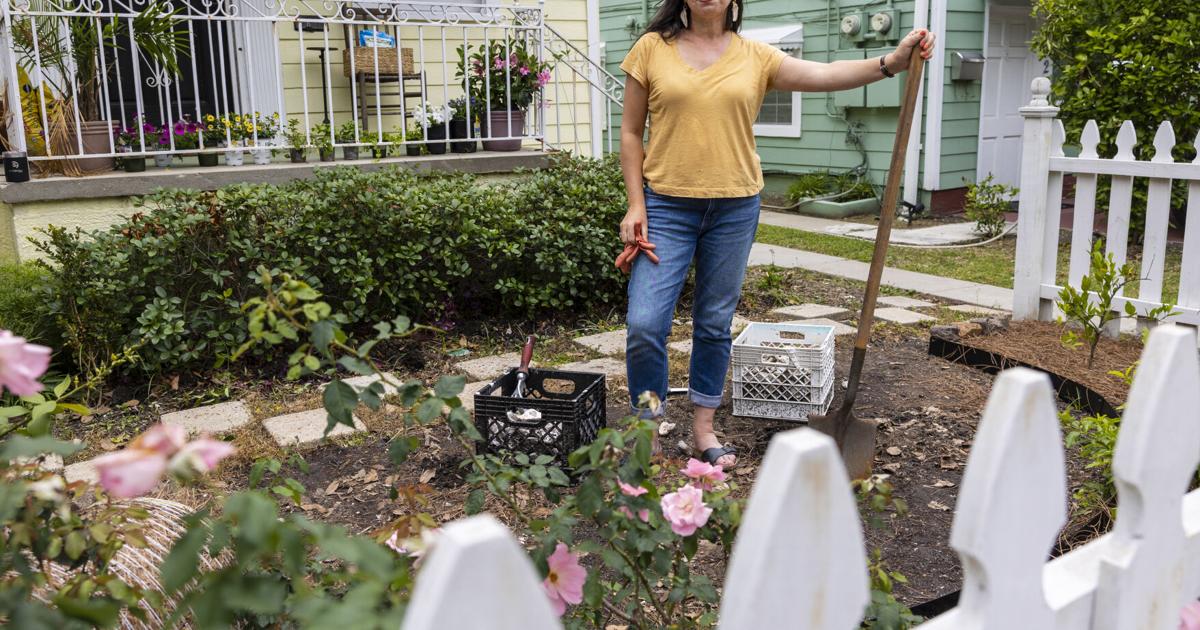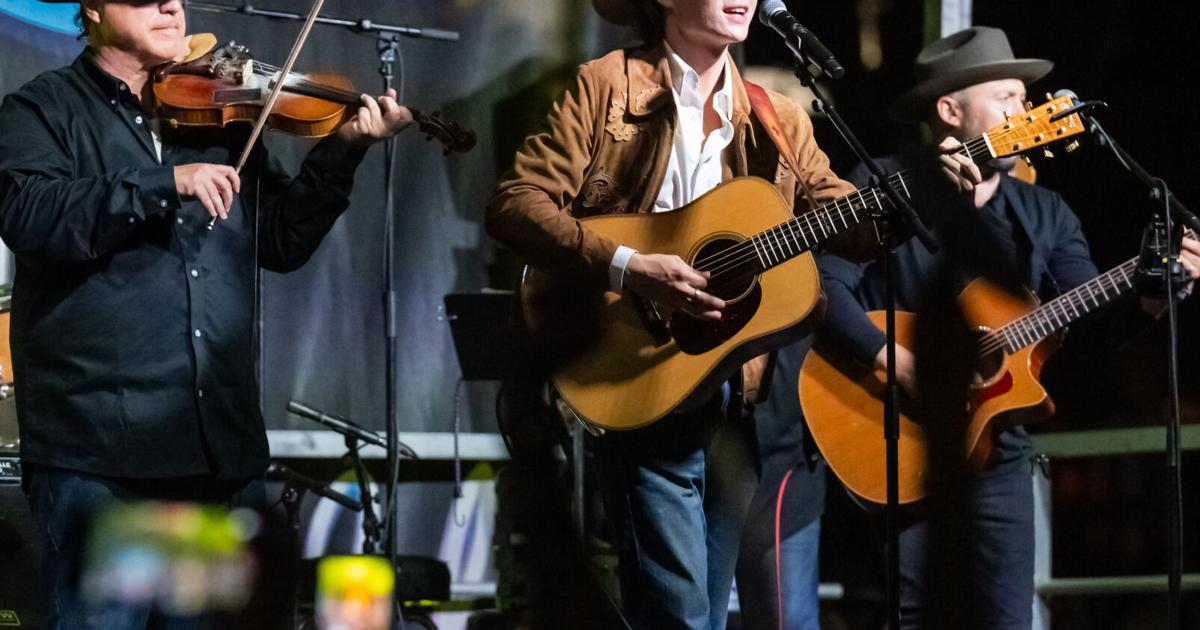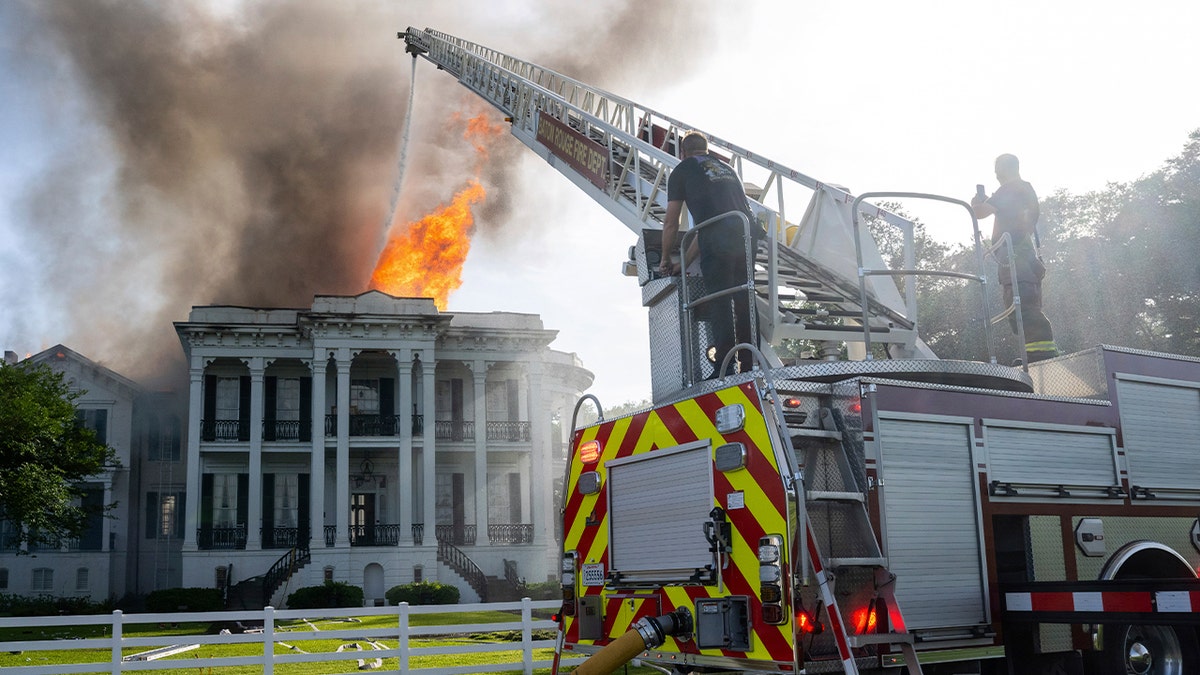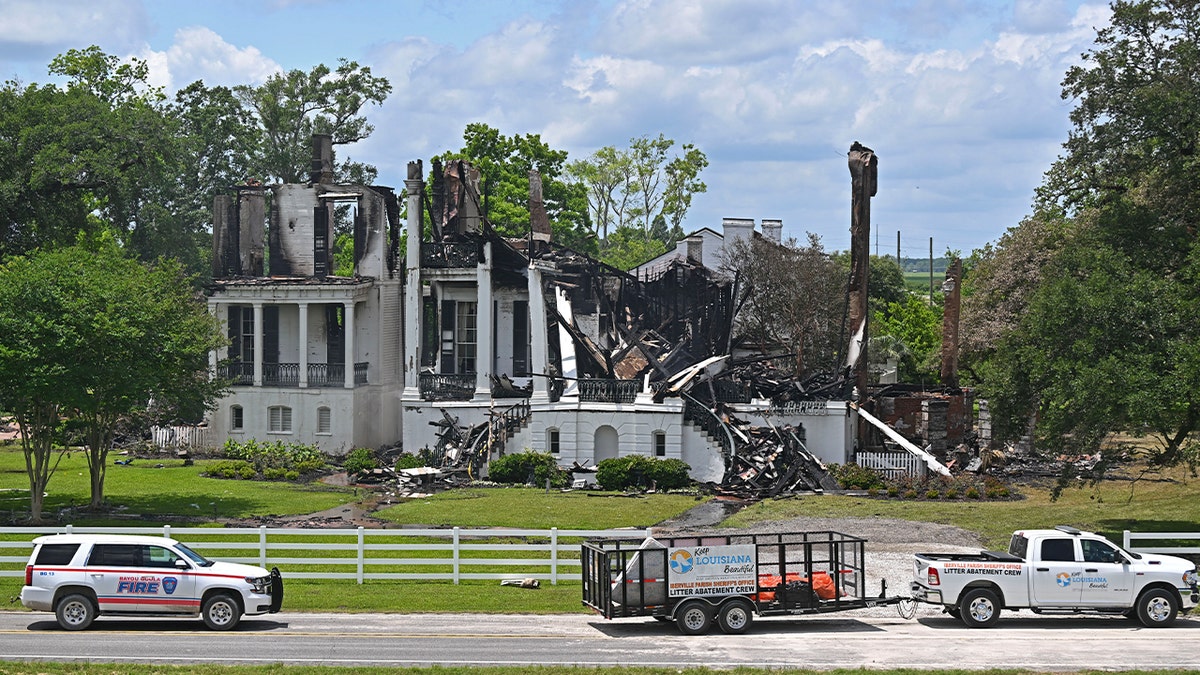Louisiana
Why is my garden full of oyster shells? Curious Louisiana digs in.

When Kyran Pittman gardens in her yard in the Marlyville-Fontainebleau neighborhood of Uptown New Orleans, she can’t dig for more than a few inches before hitting “old, gnarly, large” oyster shells and clam shells, she said.
Why? Her home on Walmsley Avenue is nowhere near a body of water, and it doesn’t occupy a spot where a nearby restaurant or oyster bar might have tossed leftovers.
Kyran Pittman digs up old discarded oyster shells in the garden in the front yard of her New Orleans home on Tuesday, April 18, 2923. (Photo by Chris Granger | The Times-Picayune | The New Orleans Advocate)
Nevertheless, “every time I stick a spade in the soil, I have to go through the oyster layer,” Pittman said. “How did they get in my dirt, and why are they there at all?”
The answer, it turns out, lies in the ground beneath Pittman’s feet — or, rather, the elevated ground beneath her feet.
A former dairy farm
Pittman and her husband, Patrick Houston, live in a neighborhood bounded by South Carrollton and South Claiborne avenues, Audubon Street and the Illinois Central railroad line that was developed about a century ago. Their house sits on land that had been part of a dairy farm that was run around the turn of the 20th century by the Frederic sisters — Angelique, Marie Hortense and Josephine — who sold their products at the Dryades Market.

Some of the old oyster shells that Kyran Pittman has dug up in the garden in the front yard of her New Orleans home on Tuesday, April 18, 2923. (Photo by Chris Granger | The Times-Picayune | The New Orleans Advocate)
When the property was cleared and subdivided in the transformation from farm land to urban land, drainage — an ever-present aspect of New Orleans life — came into play.
As part of the development, sediment known in the trade as fill was brought in to shore up the residential blocks to make them a foot or two higher than the streets, thereby facilitating drainage, said Richard Campanella, the Tulane University geographer, whose latest book happens to be “Draining New Orleans: The 300-Year Quest to Dewater the Crescent City.”
“The fill could have come from anywhere,” he said.
The oyster krewe
Hence the presence of all those shells. “They’re enormous. They’re liberally mixed into that topsoil,” said Pittman, who not only loves to eat oysters but also marches with the Bearded Oysters Carnival krewe.

Kyran Pittman digs up old discarded oyster shells in the garden in the front yard of her New Orleans home on Tuesday, April 18, 2923. (Photo by Chris Granger | The Times-Picayune | The New Orleans Advocate)
Although Pittman crafts throws from some of the oysters she finds in her yard, the undisturbed shells can be good for her vegetation, said Dan Gill, a retired associate professor of horticulture at LSU AgCenter and The Times-Picayune’s longtime lawn and garden columnist.
Shells are made of calcium carbonate. Over time, calcium from those shells — an essential element for healthy plants — can go into the soil, Gill said, and the shells can help aerate the soil and keep it from compacting.
“Sometimes soils are too acidic,” he said. “Lime or calcium carbonate mixes with soil to make crops grow better.”

Kyran Pittman digs up old discarded oyster shells in the garden in the front yard of her New Orleans home on Tuesday, April 18, 2923. (Photo by Chris Granger | The Times-Picayune | The New Orleans Advocate)
Shells aren’t the only things that Pittman — a self-confessed history geek and French Quarter walking-tour guide — is finding when she digs in her yard.
Among the detritus her spade has turned up are an intact seltzer bottle more than a century old, horseshoes, big rusty nails and bits of hardware and crockery.
“Our neighborhood has been in the throes of road improvements for what seems like forever, and the workers leave plenty of trash and construction materials behind them,” Pittman said. “I hope their litter ages half as picturesquely.”

Louisiana
Louisiana’s John Foster finishes second on ‘American Idol.’ Jamal Roberts of Mississippi wins.

After rocketing to “American Idol’s” top 3, Louisiana teen John Foster finished second in the ABC singing competition series during its grand finale on Sunday night.
Grabbing the “Idol” title was Jamal Roberts, 27, of Meridian, Mississippi, an elementary school physical education teacher.
Roberts’ finale songs included “First Time” and “Just My Imagination (Running Away With Me)”.
Mississippi’s Jamal Roberts won the ‘American Idol’ title on Sunday night. Louisiana teen John Foster finished second.
Finishing third was Breanna Nix, 25, a stay-at-home mom from Denton, Texas.
Foster started off the finale with a bang, performing his first solo song of the night, “Courtesy of the Red, White and Blue (The Angry American)” by the late Toby Keith.
“Now, John. Now, now, John. That’s the way you run for office. I mean, you run — you run. That’s the way you work it for ‘American Idol,’” judge Lionel Richie said.
“You know, it’s the time to pull out all the stops and you’re pulling out all the stops. I’m so proud of you and all you have accomplished about this whole competition,” judge Carrie Underwood said. “I felt like I was at a John Foster concert.”
“Yeah. Your growth … Your voice has gotten better and, and everything has grown. It’s been a privilege, a privilege to watch that happen. It’s been amazing,” judge Luke Bryan added.
Foster’s songs for the finale
Later in the show, Foster returned to the stage for his second solo song, “Take Me Home, Country Roads,” a hitmaker for ’70s folk/country artist, the late John Denver.
“I just want to see that birth certificate one more time,” Richie joked with Foster, alluding to the maturity and polish of his vocals. “And secondly, for all of you out there, vote, vote, vote.”
Underwood followed him by saying, “Of course, the country boy would have an amazing hometown welcome. That was such a great thing to watch.”
“Yeah, that, that hometown piece, I mean, woo, I can’t take that,” Bryan chimed in. “It was really beautifully done. And hell, I’ve never seen a crawfish that big. I need to, can that thing come to Tennessee?”
Foster rode a giant Mardi Gras-style crawfish float in Wednesday’s homecoming parade in Addis.
The Louisiana singer and Bryan later teamed up for a performance of Randy Travis’ 1988 hit, “Deeper Than the Holler,” a mid-tempo ballad.
The top three finalists opened the three-hour live coast-to-coast broadcast with a performance of Queen’s “We Are the Champions.”
Foster, a biology major at LSU who just finished his freshman year, first grabbed the judges’ attention during his audition in Nashville, Tennessee. He brought each of them a Louisiana care package of boudin, beef jerky, pork sausage and Benoit’s Cajun seasoning from his family’s business, Benoit’s Country Meat Block in Addis.
Foster’s audition song, “Don’t Rock the Jukebox” by Alan Jackson, prompted judge and former “Idol” Underwood to ask for another song that would more fully showcase his vocals.
“Goodbye Time” by Conway Twitty proved the perfect choice, with Bryan singing along and the other judges pleased with what they heard.
“There’s such a sweet spot in your voice, and that really brought that out,” Underwood said.
“You’ve got a lot of great tools. That last song really showed us that,” added Bryan.
One successful week after another
Foster went on to prove himself week after week — whether it was with performances of Elvis’ “Jailhouse Rock,” Travis’ “I Told You So” or his home-state favorite, Garth Brooks’ “Callin’ Baton Rouge.”
His tearful original song, “Tell That Angel I Love Her” about his high school friend who was killed in a tragic accident, was in sharp contrast to the lively and fun “Bare Necessities” from “The Jungle Book,” demonstrating his versatility.
“When you open your mouth on this song, you’re country, but you’re also storytelling country,” Richie told Foster after his “Tell That Angel” performance. “Now whether that’s old, new, happening now, later, whatever the case may be, it was so believable and I heard every word of every part of your story — and that’s what great music is about.”
Foster told the judges that he wrote the song for Maggie Dunn. Dunn and another friend, Caroline Gill, both of Brusly, were killed on New Year’s Eve 2022 when an Addis police officer ran a red light during a high-speed pursuit.
Foster also sang the song at his mini-concert in Plaquemine on Wednesday night, capping off his hero’s welcome home-state visit, which was documented in the Sunday-night finale, including footage of Foster becoming emotional during his performance of “Tell That Angel I Love Her” at his hometown concert.
If you missed Sunday night’s show, it will be available on Hulu starting Monday.
Louisiana
Louisiana’s John Foster sings in ‘American Idol’ Sunday finale — here’s how to watch and vote

‘American Idol’s’ current top 10 are, from left, Canaan James Hill, Breanna Nix, Slater Nalley, Thunderstorm Artis, Kolbi Jordan, Mattie Pruitt, Gabby Samone, Louisiana’s John Foster, Jamal Roberts and Josh King. At far right is the season’s artist-in-residence Jelly Roll.
Louisiana
America's largest remaining antebellum mansion burns down in devastating fire

Historic Nottoway Plantation, the largest antebellum mansion in the U.S., burned to the ground this week after a fire broke out on Thursday. There have been no reports of injuries or deaths connected to the fire.
Fire crews worked to extinguish the flames with water reportedly being poured onto the rubble as long as 18 hours after the fire started, according to Fox 8. As of Saturday, the cause of the fire was still under investigation.
“Some staff members stated they had gone into the museum and there was smoke. When they returned, the whole room was in flames,” Iberville Parish President Chris Daigle told Fox 8, adding that it was “a total loss.”
Fire crews move in a line around the now fully engulfed the Nottoway Plantation on Thursday, May 15, 2025, in White Castle, La. (Michael Johnson/The Advocate via AP)
2 DEAD AFTER HOUSE BURNS DOWN IN NEW JERSEY FOLLOWING ‘GIGANTIC EXPLOSION,’ CRIMINAL INVESTIGATION UNDERWAY
Daigle noted in a post on the Iberville Parish Government’s Facebook page that “The loss of Nottoway is not just a loss for Iberville Parish, but for the entire state of Louisiana. It was a cornerstone of our tourism economy and a site of national significance.”
The 64-room mansion was built by John Hampden Randolph in the late 1850s, according to multiple sources. It sat on more than 53,000 square feet and — in addition to the dozens of rooms — it contained 365 doors and windows and 22 white columns, Fox 8 reported. The property overlooked the Mississippi River.

Firefighters from Baton Rouge battle a blaze as flames burst from the roof of the Nottoway Plantation on Thursday, May 15, 2025, in White Castle, La. (Michael Johnson /The Advocate via AP)
NJ WILDFIRE SCORCHES 13,500 ACRES AS FIREFIGHTERS WORK TOWARD CONTAINMENT
Randolph first arrived in Louisiana in 1841 and began by planting cotton, but ultimately shifted to sugar cane, according to the LSU Scholarly Repository. The scholarly repository article also notes that the mansion was named “Nottoway” after the county in Virginia where his ancestors lived.
U.S. Department of the Interior records cited by Axios show that Randolph owned 155 slaves and 6,200 acres of land by 1860.
In addition to the luxurious mansion, the property also featured several trees that are over 100 years old, several of which are more than 120 years old, according to Nottoway Plantation’s website.

Light smoke can be seen from a handful of active hot spots as crews remain on scene after a fire on Thursday engulfed the historic Nottoway Plantation, Friday, May 16, 2025, in White Castle, La. (Hilary Scheinuk/The Advocate via AP)
CLICK HERE TO GET THE FOX NEWS APP
In modern times, the mansion and the surrounding property functioned as a museum, resort and wedding venue. Nottoway Plantation’s website states that it sat on 31 acres, which included 40 overnight rooms, a bar, a restaurant, event space, a pool, tennis courts and more.
“While its early history is undeniably tied to a time of great injustice, over the last several decades it evolved into a place of reflection, education, and dialogue,” Daigle wrote in the Facebook post. “Since the 1980s, it has welcomed visitors from around the world who came to appreciate its architecture and confront the legacies of its era. It stood as both a cautionary monument and a testament to the importance of preserving history — even the painful parts — so that future generations can learn and grow from it.”
-

 Austin, TX1 week ago
Austin, TX1 week agoBest Austin Salads – 15 Food Places For Good Greens!
-

 World1 week ago
World1 week agoNew German chancellor aims for stronger EU ties with France and Poland
-

 Technology1 week ago
Technology1 week agoThe best iPad to buy
-

 Lifestyle1 week ago
Lifestyle1 week agoA Guide to Bravo’s New Shows, Including “Wife Swap: The Real Housewives Edition”
-

 News1 week ago
News1 week agoJudge Orders Release of Rumeysa Ozturk, Tufts Student Detained by ICE
-

 News1 week ago
News1 week agoTrump cuts tariffs on U.K. cars, steel and aluminum but keeps 10% base duty
-

 Business1 week ago
Business1 week agoA Decade-Long Search for a Battery That Can End the Gasoline Era
-

 Culture1 week ago
Culture1 week agoBook Review: ‘The Family Dynamic,’ by Susan Dominus




















